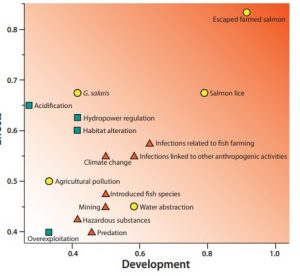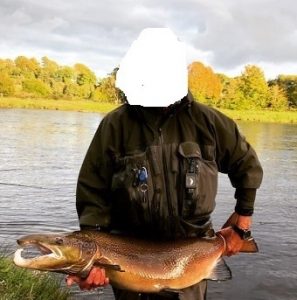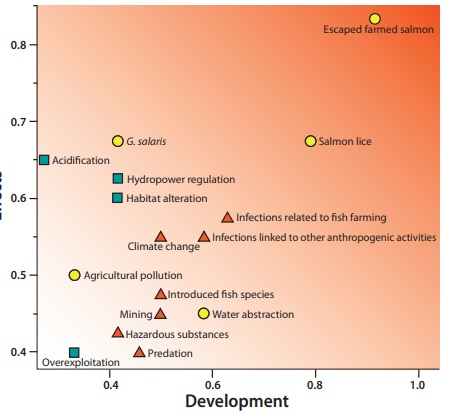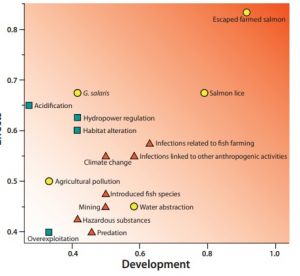Good relations: BBC TV’s ‘The One Show’ report on the loss of salmon from the Carradale farm due to Storm Ellen was finally broadcast this week. This will be the first time that most of us will have seen Polly Burns, Fisheries Management Scotland’s new Aquaculture Interactions Manager who was interviewed for the programme, suggesting that farmed salmon can weaken the genetics of the wild fish but that there was a need to understand the genetics of the wild fish, (something I will return to later).
Ms Burn’s appearance on television followed closely after news broke that Fisheries Management Scotland had issued a 17-page objection to the Argyll & Bute Council planning office in relation to a proposed new farm at North Kilbrannan. The objection was signed and presumably written by Polly Burns in her role as Aquaculture Interactions Manager.
The Scottish Government are keen to highlight that wild salmon are subjected to a range of high level pressures, of which aquaculture is just one, yet so far there has only been consideration of aquaculture, as illustrated by the formation of a Salmon Interactions Working Group (SIWG). Even though quite clearly some of these other high level pressures have more impact on wild salmon populations than aquaculture, there has been no attempt to establish further working groups to consider the impacts of barriers, predators, water quality and the other pressures.
Fisheries Management Scotland clearly see that consideration of the other pressures are much less important than continuing to focus on the impacts of aquaculture, hence the decision to recruit an Aquaculture Interactions Manager. However, what was more puzzling was that the new position was to be funded by Marine Scotland, not by the various District Salmon Fisheries Boards. It could be argued that in the interests of balance, they should have funded a similar position to enable the aquaculture industry to interact with the wild fish sector.
As someone working on wild and farmed salmon interactions, I was interested to understand the rationale behind Marine Scotland’s funding of this position rather than say, invest the money in better understanding some of the other high level pressures. The then director of Marine Scotland Graham Black replied to say that the post was created to help foster a good relationship between the wild and the farmed sectors to allow sustainable development of the fish farming industry.
Submitting an objection to the development of a sustainable salmon farming industry does not in my opinion seem the best way to encourage a good working relationship. Instead, it seems to me that there has been little change, based on the same long-standing preconceptions. This is not surprising since in my experience, the wild fish sector including Fisheries Management Scotland are not interested in hearing anything but their own narrative,
The objection document quotes a couple of scientific papers from Norway but only cites one. This is a paper by Torben Forseth and others that was published in the ICES Journal of Marine Science in 2017. The paper is titled ‘The major threats to Atlantic salmon in Norway’.
The reference to this paper states: ‘It is notable that escaped farmed salmon, salmon lice and infections related to salmon farming are considered to be the greatest anthropogenic threats to Norwegian wild salmon’. This is threats to wild salmon due to human activity.
This graphic taken from this paper shows the various threats faced by wild salmon. It is only necessary to know that those threats positioned towards top right are the greatest and those in bottom left are the least. The paper includes an explanation as to how they arrived at these conclusions. The paper is taken from the annual review of threats to wild salmon published by the Norwegian Expert Committee on Wild Salmon.

To try to explain this graphic, I would like you to compare two of these threats to wild salmon.
Threat 1 resulted in the estimated deaths of 39,000 wild salmon in Norway.
Threat 2 resulted in the confirmed deaths of 135,413 wild salmon in Norway.
If it helps in arriving at a decision, threat 1 is based on sampling, extrapolation, and mathematical modelling with no actual carcasses. Threat 2 is reported actual deaths.
I am sure that everyone reading this commentary arrived at the correct answer that the greatest of the two threats is threat 1.
In relation to the graphic, threat one is the estimated loss of salmon due to sea lice, whilst threat 2 is over-exploitation which is judged to be the least threat to wild salmon despite consisting of 82,365 wild salmon caught in rivers by rod and line and a further 53,048 wild salmon caught at sea by commercial fishermen. All these fish were killed at the time of catching.
The obvious question is why, even if the figure of 39,000 wild salmon killed by sea lice was correct, which it is not, why is this considered a greater threat than exploitation by anglers and fishermen? The answer is simply that killing nearly 136,000 wild salmon is not considered over-exploitation, but rather the normal exploitation of wild fish, which they do not perceive to be a problem.
I have tried to understand the logic as to why deliberate killing of more than three times as many salmon as estimated die from sea lice is less of a threat to wild salmon and have sought an explanation from the Expert Group. Unfortunately, they will not respond to me because they believe that I might misrepresent their views. Can this comparison of numbers of dead fish be judged to misrepresent the facts?
Since the Expert Group will not explain the reasoning why salmon farming is perceived to be the greatest threat, perhaps, Ms Burns might like to do so instead. After all, she has signed her name to an objection to a salmon farm that is based on the Expert Group’s work. Equally, a better understanding of this science should help foster a better relationship between the wild and the farming sectors, which is what Ms Burns was employed to do.
Special: Fish Farming Expert reports that Salmon & Trout Conservation has formally notified Nature Scotland that environmental damage that either has or may be about to be caused to wild fish stocks in Special Areas of Conservation (SAC) following the incident at Carradale during Storm Ellen. S&TC say that under European law the process requires agencies to undertake a formal examination of what occurred and do what they can to prevent further damage occurring to the wild salmon populations in the SAC’s affected.
In a press release, S&TC solicitor Guy Linley-Adams said that S&TC are putting the competent authorities on formal notice that they should take necessary remedial action and oblige the farming company to avoid further damage to the Special Areas of Conservation. Andrew Graham Stewart, Director of S&TC told Fish Farming Expert that they cannot tell Nature Scotland what action they should take but if S&TC feel that it is inadequate then they will consider their options.
Fish Farming Expert says that there are three Special Areas of Conservation that might be affected. The River Endrick in Scotland and the River Derwent and Bassenthwaite and the River Eden in England.
I am loathe to debate issues of European Law with a lawyer but at the same time, the matters raised relate to wild salmon and Special Areas of Conservation and this is an issue of which I have had some experience. In my opinion, Salmon & Trout Conservation are so wrapped up in trying to undermine the salmon farming industry that they fail to recognise when they are mistaken. I would be more than happy to discuss Special Areas of Conservation with them but Salmon & Trout Conservation refuse to acknowledge any correspondence. My only option is to highlight the issues, here in reLAKSation in order to promote wider discussion.
There are 656 Special Areas of Conservation in the UK that were established through the EU Habitats Directive. Of these, 35 are relevant to Atlantic salmon and 17 of these are located in Scotland. Of the seventeen, salmon was the primary reason why the site was selected in eleven SACs and the other six were selected because salmon was a qualifying feature but not the primary reason for selection. One of these six is Endrick Water, which falls into the area covered by S&TC’s concerns but the main reason why Endrick Water was deemed worthy to be an SAC was its population of both Brook and River Lampreys.
The reason why the Rivers Derwent and Eden were selected as SACs was because in the case of the Derwent, it was considered a good example of a large oligotrophic river flowing over base-poor geology. By comparison, the River Eden is deemed to be a good example of a large river system that flows over varied base rich geology.
The descriptions of why the rivers Derwent and Eden were selected as Special Areas of Conservation give a clue as to why S&TC’s demands are likely to be rejected. If S&TC consider that free swimming farmed salmon could damage the integrity of the SAC then surely, catching and killing wild salmon in an SAC must also be a cause of damage. For example, the River Tay is a river that has been classified as a Special Area of Conservation for Atlantic salmon and hence it makes no sense at all that anglers can catch and kill the same wild salmon in this river. If the River Tay is a Special Area of Conservation, then surely the salmon in it should be protected. There are 16 other SAC rivers in Scotland but because the way that Marine Scotland Science treat the data, it is only possible to identify the number of fish killed in five of the 17 rivers. Since 2000, which is about when SACs came into being, a total of 208,988 salmon and grilse have been caught and killed from just five SAC rivers in Scotland.
I raised this point with the European Commission some years ago and even met with officials from the Environment Directive in Brussels on two occasions but it was made clear to me that the Special Area of Conservation classification through the Habitats Directive, which established Special Areas of Conservation applies to the habitat not the species. Direct protection of the fish would fall under different legislation.
As far as I am aware, the impact of Storm Ellen on the farm structure did not cause any damage to any of the three SAC habitats listed by Salmon & Trout Conservation. In my opinion, Salmon & Trout Conservation’s complaint will make no difference as the incident did not impact directly on any of the SACs. It should be also considered that the number of fish of farmed origin caught from these rivers is extremely small, especially compared to the hundreds of thousands of fish killed in other SAC rivers.
Finally, regular readers may remember that I wrote in reLAKSation that the BBC had reported that Carradale fish had been allegedly caught from three English rivers including the River Ehen. As it happens the River Ehen is also a river classified as a Special Area of Conservation although the primary reason for this classification is the habitat freshwater mussels whilst Atlantic salmon are a qualifying feature. News about the fish in the River Ehen appeared a few days before the S&TC issued their press release so the omission of this river SAC from their statement is inexcusable.
Interestingly, there is another river, with Special Area of Conservation status, that is located between Carradale and the English rivers. This is the River Bladnoch in South West Scotland. Salmon & Trout Conservation make no mention of this river and the local fisheries trust makes no reference to the incident or the possibility that fish from the farm might be caught in the river.
‘One Show’: As mentioned above, the One Show finally broadcast its report on the storm damaged farm although it was moved from BBC 1 to BBC 2 to give way to the Prime Minister’s Covid report. It was a shame it was given any coverage at all because this was not much of a story for national television. There are probably not many members of the public who wish to hear from a group of whinging anglers who blame salmon farming for the fact that there aren’t enough wild fish for them to kill.
The reporter Joe Crowley is also a keen angler and has a record for fronting reports that blame salmon farming for declines of wild fish. He makes his position clear through his comments and tweets. It was therefore interesting how Mr Crowley described Polly Burns’ role in his report.
He said that: ‘Polly Burns is from an organisation dedicated to safeguarding Scotland’s wild fish population.’ Given this description, I now wonder if we can now expect a name change by Fisheries Management Scotland to Fisheries Conservation Scotland following on from a similar change by the Salmon & Trout Association, who were keen to playdown their fishing connections to the wider media. After all, the name ‘Fisheries Management Scotland’ does not imply that the organisations main role is to protect wild fish but rather to protect fisheries. By definition, a fishery is where fish are caught, not protected.
On their website, FMS state that their vision is:
“To be the pre-eminent, representative fisheries management body in Scotland, recognised as such by local fishery management, Governments and other agencies”
And their objectives are to:
- “Promote and ensure the best fisheries management for the protection, preservation and development of Scotland’s wild salmon and freshwater fish, along with their fisheries and environment.
- Represent the interests of our member organisations”.
To be fair to FMS, their home page now states that their members ‘work to conserve Scotland’s valuable and iconic wild freshwater fish and fisheries and the aquatic environment on which they depend’.
It is only necessary to look on Twitter to see how their members work to conserve valuable fish. The following is just one of many examples posted by member organisations:

The caption states: ‘well done o one of our regular rods with this 25lb old boy.’
Given that the Fishery Board is a member of FMS, who have supported the publication of a guide to catch and release, it is surprising that the caption doesn’t say, this angler is not following our advice for catch and release. The guide clearly states that: ‘a photograph can be taken as you briefly lift the fish out of the water. Keep the fish in or briefly just above the water.” Yet, this fish is well away from the river surface.
Of even more concern is why are anglers catching fish that are clearly in breeding condition and having had to spend time being dragged around at the end of a line with a hook in its mouth, the photo shows the fish being manhandled. Catch and Release may not directly kill wild fish but the stress of being caught may impact the fish’s breeding potential. The fishing season on some rivers ends at the end of October leaving salmon with less than two months without disturbance from anglers. As FMS say that they want to protect wild fish, perhaps the season should end earlier to allow the fish to breed undisturbed.


